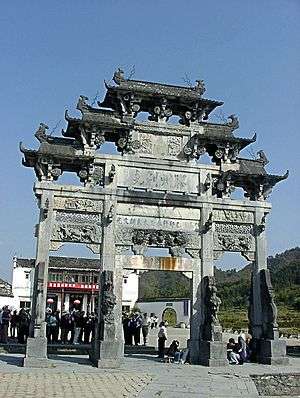Huizhou, Anhui
Huīzhōu (Chinese: 徽州) now is a district (Huizhou District, Chinese: 徽州区) in southeastern China, located in Huangshan City – the southernmost region of Anhui Province. Before the 1987 administrative division adjustment, Huizhou was a region corresponding to Huangshan city and Jixi County of Anhui Province, plus Wuyuan County in northeastern Jiangxi Province. Anhui, the name of the province, is a portmanteau word combining the first characters of Anqing and Huizhou.
Huizhou 徽州 | |
|---|---|
Region | |
 Xidi, a World Heritage Site, is a village in Huizhou that was built by a merchant family during the Ming Dynasty | |
.png) | |
| Country | China |
| Province | Anhui and Jiangxi |
| Area | |
| • Total | 13,870 km2 (5,360 sq mi) |
| Population (2010) | |
| • Total | c. 1,984,000 |
History
During the Song dynasty (1211), Huizhou was named from Shezhou or She Prefecture (歙), now the name of She County under Huangshan City. The prefecture remained intact for about 800 years with six counties: Shexian County (歙县), Yixian County (黟县), Xiuning (休宁), Qimen (祁门), Jixi (绩溪), and Wuyuan (婺源).
The region was known for production of writing utensils. In the late Ming dynasty, the city also became known for publishing texts on a broad range of subjects, such as genealogy, classic literature, and illustrated novels and dramas. The carvers of the printing blocks were highly skilled, allowing the printed works to be of high quality.[1]
Geography
Huizhou is a mountainous region in the south of Anhui province. Huizhou is also well known for the scenic Huangshan Mountains.
Economy
Since the Ming dynasty, the merchants of Huizhou, collectively known in Chinese as Huishang (徽商; pinyin: Huīshāng) were renowned for their economic prowess. During the Ming and Qing dynasties, they formed a formidable political force both regionally and nationally.[2]
After the Taiping Rebellion, Huizhou merchants became less prominent as the war disrupted trade in inland China.[3]
Culture
Huizhou has its own distinct culture as well as spoken Chinese form, known as Huizhou and recognized as one of the main subdivisions of spoken Chinese. Peking Opera originates in a local opera of Huizhou.
Hui cuisine, known for wide use of wild herbs, is one of eight main Chinese cuisines.
Architecture
Huizhou is famous for ancient streets and buildings, such as ancestral temple, memorial archway. Residential buildings in Huizhou attach importance to Fengshui and yinyang.
Notable people
- Zhu Xi (1130-1200)
- Huang Binhong (1865-1955)
- Hu Shih (1891-1962)
- Tao Xingzhi (1891-1946)
- Hu Xueyan (1823-1885)
- Hu Zongxian (1512-1565)
- Zhan Tianyou (1861-1919)
- Sai Xinhua (1872-1936)
- Jiang Zemin
- Hu Jintao
- Wang Zhi
References
- Kai-wing Chow (2004). Publishing, Culture, and Power in Early Modern China. Stanford University Press. pp. 88–. ISBN 978-0-8047-3368-7.
- Wong, Edward (29 March 2012). "In Rural China, Temples to Past Merchant Wealth Endure". New York Times. Retrieved 2018-01-10.
- Rowe, WIlliam T. China's Last Great Empire: The Great Qing.